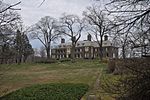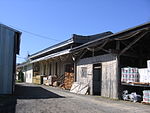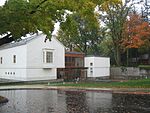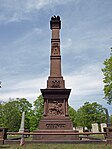Frederic Remington House
1909 establishments in ConnecticutFrederic RemingtonHistoric American Buildings Survey in ConnecticutHouses completed in 1909Houses in Ridgefield, Connecticut ... and 3 more
Houses on the National Register of Historic Places in ConnecticutNational Historic Landmarks in ConnecticutNational Register of Historic Places in Fairfield County, Connecticut

The Frederic Remington House is a historic house at 36 Oak Knoll Road in Ridgefield, Connecticut. A National Historic Landmark, it was the home of the painter and sculptor Frederic Remington (1861–1909) in the last few months of his life. Remington and his wife Eva designed the two-story gambrel-roofed, fieldstone-and-shingle house. He produced some of his finest work in the house including the sculpture The Stampede and the painting The Love Call. The house was declared a National Historic Landmark in 1965.
Excerpt from the Wikipedia article Frederic Remington House (License: CC BY-SA 3.0, Authors, Images).Frederic Remington House
Barry Avenue,
Geographical coordinates (GPS) Address Nearby Places Show on map
Geographical coordinates (GPS)
| Latitude | Longitude |
|---|---|
| N 41.284722222222 ° | E -73.516666666667 ° |
Address
Barry Avenue 147
06877
Connecticut, United States
Open on Google Maps








